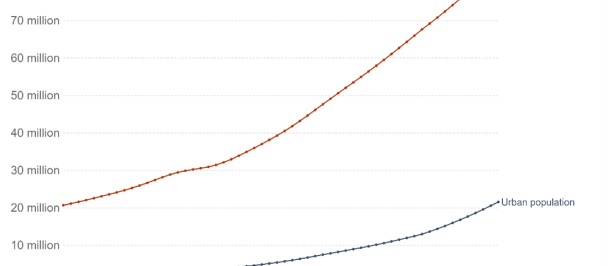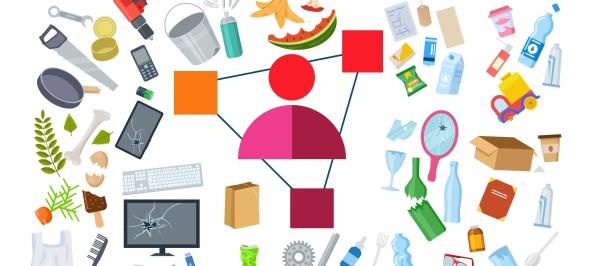Behaviour Matters: Insights from Solid Waste Transporation Experiment
December 19, 2022
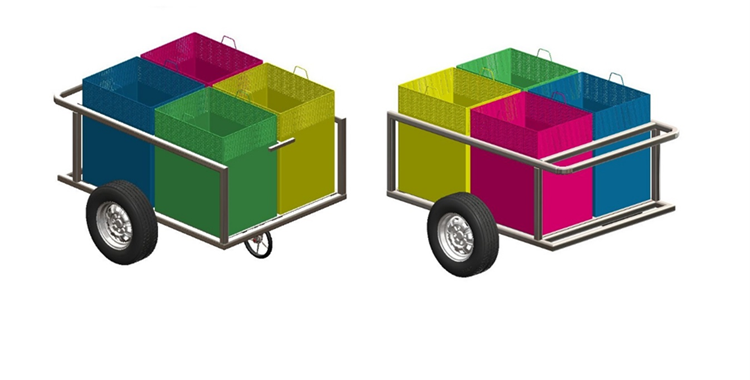
The Ethiopia accelerator lab has been working on a waste management portfolio over the past year that looked at a challenge across the waste value chain, from household segregation to transportation to recycling market linkages. You can find a full list of blogs on previous works here.
The experimentation journeys
The experimentation is a follow-up activity of a behavioural insight study on solid waste segregation and prototyping of door-to-door solid waste collection push carts. The lab has experimented with three municipalities namely, Bahir Dar, Adama and Addis Ababa. The three cities were selected because of a previous engagement, smooth relations and as a fair representation of other cities. Accelerator Lab organized a three-day boot camp for our implementing partners and solid waste collection businesses to build their experimentation capacity and co-experiment the push carts.
The general objective of the experiment was to:
- Validate a hypothesis from the behavioural study to see if improved technology, particularly a pushcart with a solution for segregated waste compartments, will improve waste segregation behaviour at the household level.
- Find issues on the prototypes to be tested and get feedback from users for improvement. These included areas of friction that users face when they interact with prototypes; identifying frequently failing parts and seeing how users deal with technical issues that may come up.
- Understand how users interact with the prototypes and evaluate the performance and efficiency of the prototypes in the actual user environment.
- Understand supply chain issues for the push carts including the availability of raw materials, and manufacturing skills particularly welding, electric power and maintainability.
The experimentation covered a total area of 7,200 m2 (approximately) and 36 residential houses in the three selected cities. The average number of households per residential house is about 2.7 and there are a total of 98 households and 372 residents (189 Male/183 Female). During the 4 weeks exercise a total of 4061 Kg of solid waste was collected from the selected neighbourhoods. Out of the total collected waste, only 771.6 Kg is segregated into two major categories (organic and inorganic). Women are mostly responsible for waste segregation and disposal, 68 % of the household waste was disposed of by female members of the household. Family members in the age range of 15 to 30 are the most responsible for waste disposal (37 %), followed by the 45 to 60 age range (27 %).
Key insights on waste segregation practice.
- We didn’t see a clear pattern between the promotion of a pushcart with compartments for segregated waste and household waste, and the segregation behaviour. In this case, the argument made by municipalities that “households are not segregating their waste because waste transporters/collectors don’t have separate waste collection carts for different types of waste and consequently are mixing the waste” may not make sense.
- Behavior and attitude change are essential in ensuring sustainable and long-lasting waste management practices. Using incentives, whether monetary or emotion-based, has been found to influence people’s behaviour and practices in waste management. For example, model households were found to have better waste segregating practices.
- Behavior and attitudinal change interventions should target women and young members of the family as these groups of households are mostly responsible for waste disposal. Interventions in schools could have the potential to bring change.
- Behavior and attitude change interventions should also include waste collectors and transporters because some of the waste collectors were found to be reluctant about waste segregation during this exercise. In addition, it is crucial to create a better value and sustainable market for organic waste.
- In the experiment, facilitating households with the tools and information to manage their waste helped households to see the value in their waste. some households that have been provided with different types of sacks for waste collection have better waste segregating practices. Some of the households segregating their waste mentioned that segregating waste makes the waste collectors' life easier, and they do segregation because it’s also a moral and ethical issue.
Insights from Performance and Functionality Tests
From the deep dive exercise conducted at the early stages of this process, we learned that it took the waste collectors about two hours to collect all the waste from the neighbourhood and temporarily store it at collection points. With the new prototypes, it took waste collectors only about 75 minutes to collect an equivalent size of waste with a similar group. The main reasons for this are;
- The prototypes are stable and easy to operate. As a result,
all the operators can participate in loading/unloading activities.
- The prototypes have extendable loading capacity depending on the type of road and waste, helping waste collectors to collect a bigger volume of waste in a single batch.
- Because of the tilted design of the pushcart, unloading time is reduced by 50 % to 60 % compared to traditional pushcarts.
- The smaller-sized pushcart prototype was convenient for women members of the enterprises and increased their active participation in the door-to-door waste collection.
- No/insignificant time off for maintenance during working hours.
In general, prototypes 1 and 2 were found to be more efficient, durable, safe for operation and convenient for the users. We didn’t observe any technical issues with the third prototype. However, we found its detachable waste boxes are not desirable to waste collectors. It’s perceived as an additional burden, and we have observed almost all waste collectors removed the boxes/waste compartments while collecting waste. Beyond the desirability issue, unloading waste was a challenge for the waste collectors due to its heavy weight.
Regular visual inspections are made to ensure safe operation during the experiment and two items that wear off are identified and design modifications made.
Below are the two parts that are subjected to a significant wearing problem.
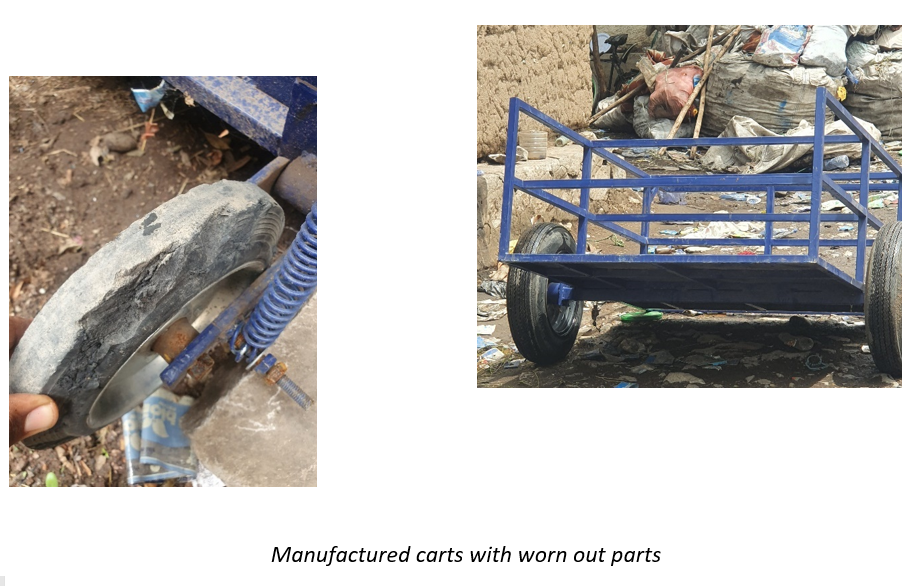
Insights from user acceptability tests
The lab team measured usability of the prototypes with three metrics: effectiveness, efficiency, and user’s satisfaction. Effectiveness relates to the goal of using the product to the accuracy and completeness with which these goals can be achieved. Common measures of effectiveness include time of task completion, frequency of maintenance, frequency of assistance to the user from the testers. It does not take account of how the goals were achieved, only the extent to which they were achieved. Efficiency relates the level of effectiveness achieved to the quantity of resources expended. Three municipality experts and nine waste collectors/transporters participated in this user acceptability testing and below is the average scoring of the participants.
|
|
Metrics (Average) |
||
|
Effectiveness (0 to 5) |
Efficiency (0 to 5) |
satisfaction (0 to 5) |
|
|
Prototype 1 |
4.7 |
4.5 |
4.5 |
|
Prototype 2 |
4.4 |
4.4 |
4.7 |
|
Prototype 3 |
4.2 |
3.9 |
3.7 |
0 = very poor, 1 = poor, 2 = satisfactory, 3 = good, 4 = very good, 5 = excellent.
The team made some design amendments as per the user’s feedback mainly on center of mass, angle of the handle and leg arm of the pushcart.
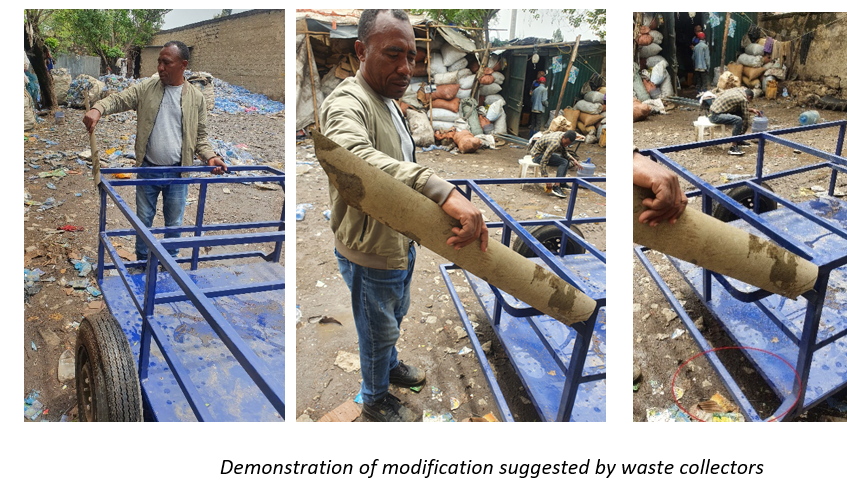
Insights from supply chain tests
Establishing a sustainable product supply chain involves three aspects in particular: good raw materials, good technical skills and good design. Quality control is then necessary to ensure these aspects are maintained at a high level and there existing capacities like Technical and Vocational Education and Training (TVET) institutes to ensure product quality. . The raw materials for the pushcarts are well specified in the design and tested to be accessible in the selected cities and mostly at zonal and regional levels. The test also confirmed that there are qualified welding and fabrication workshops to fabricate the cart in the selected cities. However, it is apparent that there should be a strategy and division of roles and responsibilities among actors to ensure adoption by the users.
Next steps
The accelerator lab will officially launch the product, document, and publish learnings from the exercise on solid waste management for a wide dissemination. Accelerator Lab will also make the design and manufacturing methods of the tested solid waste collection push carts available for municipalities and all interested actors as an open-source resource. Moreover, Accelerator Lab will broker partnerships between municipalities and corporates like Coca cola and Unilever for potential scale of the solution and learnings.

 Locations
Locations
